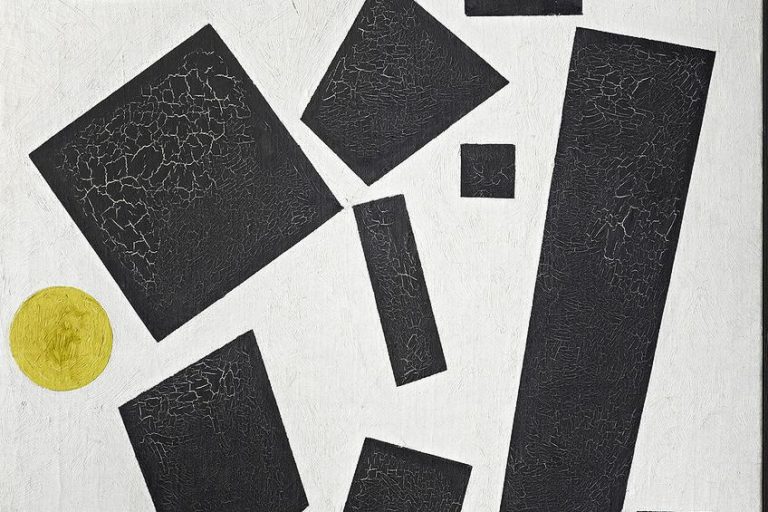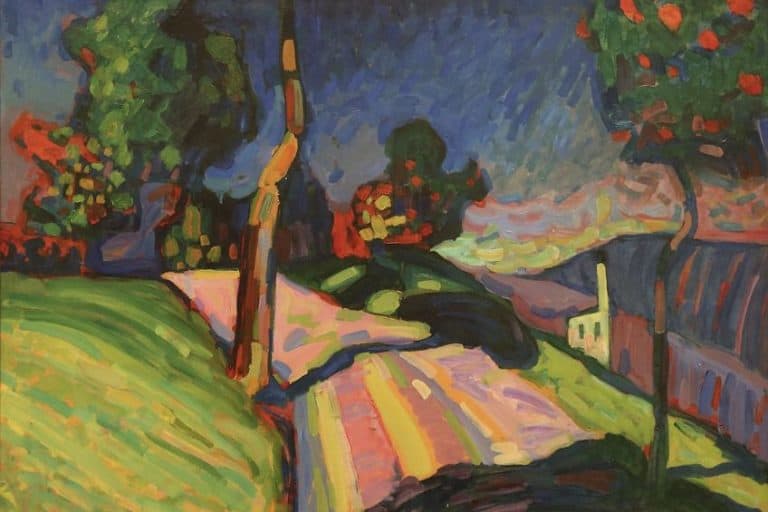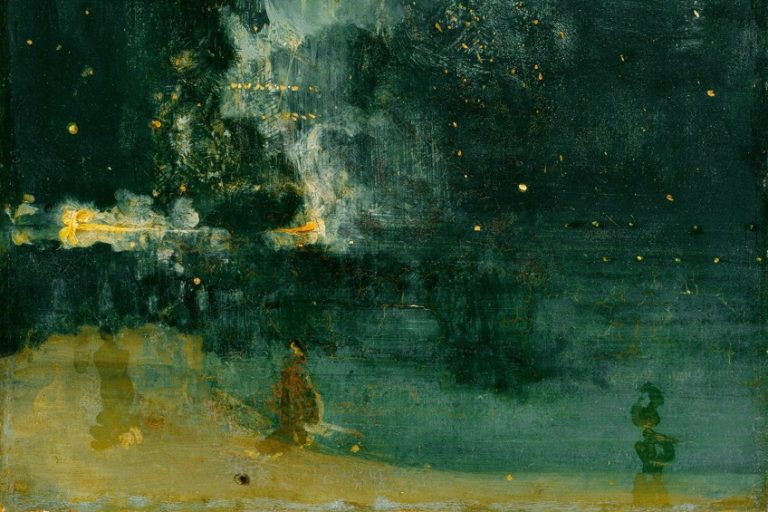Mycenaean Art – A Deep Dive into Mycenaean Artifacts
The Mycenaean people were native Greeks who lived on mainland Greece throughout the mid to late Aegean Bronze Age, millennia before the rise of Classical Greek culture as we know it today. The Mycenaeans were a knowledgeable society that had a distinct culture and considerable trading practices, and were also influenced by the Minoans. This article will explore the various aspects of Mycenaean art, such as Mycenaean frescoes, Mycenaean paintings, Mycenaean artifacts, and Mycenaean sculptures.
A Brief History of Mycenaean Art
Mycenaean art flourished in ancient Greece throughout the Bronze Age, approximately from the 16th to the 11th centuries BCE. The Mycenaeans were named after the metropolis of Mycenae, which was among the civilization’s most prominent hubs. Mycenaean art was significantly inspired by older cultures, such as the Minoans of the island of Crete. Mycenaean art also exhibits influences from Near Eastern cultures, notably the Hittites. The Mycenaean era was a prosperous epoch, and the civilization was noted for its magnificent palaces, castles, and tombs. With enormous structures, exquisite frescoes, and opulent gold jewelry, Mycenaean art symbolizes this prosperity and influence. The Lion Gate at Mycenae is a well-known specimen of Mycenaean art.
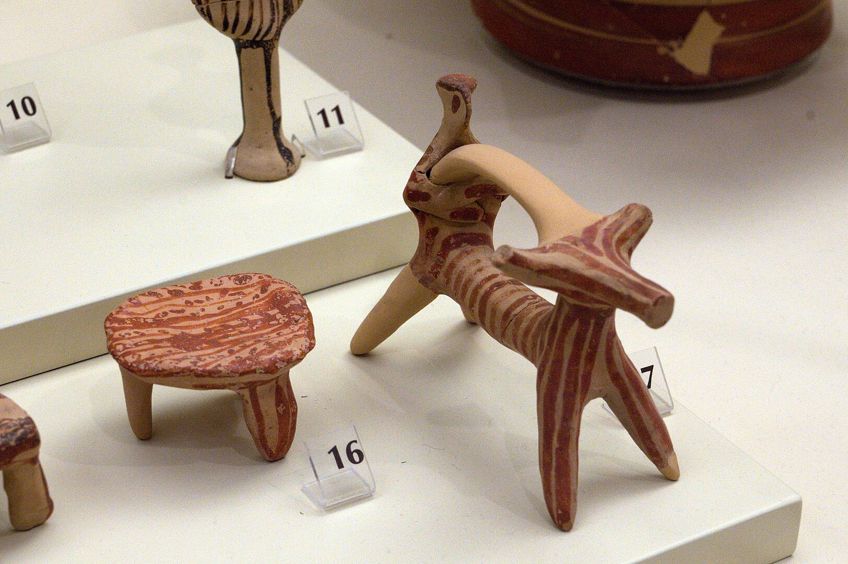
This gate has two lion statues cut from a single piece of limestone. The Lion Gate is an exceptional example of monumental construction in the Mycenaean era. Mycenaean art also features a vast range of ceramics, ranging from modest storage jars to ornately adorned vases. Geometric designs and motifs from ordinary life, like fishing, hunting, and farming, were regularly used to embellish Mycenaean ceramics. The Mycenaean civilization died out about the 11th century BCE, likely as a result of a mixture of circumstances including invasions, internal strife, and natural calamities.
As civilization perished, Mycenaean art and architecture influenced the subsequent cultures, notably the ancient Greeks.
Exploring Mycenaean Art
While direct ancestral relationships between Aegean cultures had been hypothesized but not definitely established for many years, current linguistic, genetic, and archeological research has revealed that the Mycenaeans and Minoans are substantially related to ancient and modern Greeks. Nowadays, Mycenaeans are most recognized for the wealth of Mycenaean artifacts discovered buried beneath the ruins of Mycenae, the largest of several recognized Mycenaean citadels.
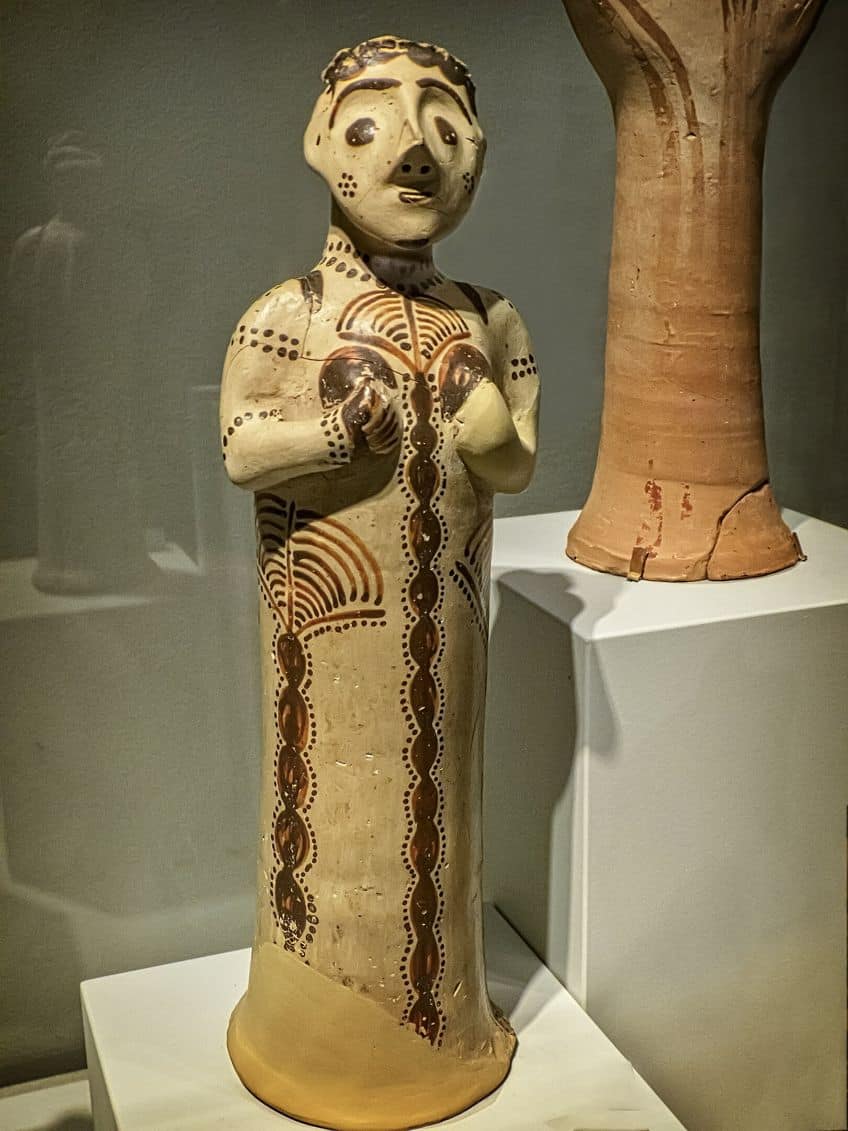
Mycenaean Artifacts
With its immense stone structures, Mycenaean architecture is often referred to as Cyclopean, a reference to the Greek mythological giant Cyclops. The beehive-shaped tomb is one monumental type that was built mostly of ashlar masonry and occasionally covered in dirt to seem like a natural mound. The greatest of these tombs, discovered just outside the Mycenae citadel, is commonly known as the Treasury of Atreus, (Atreus was a mythological Mycenaean ruler). While this tomb was plundered before any documentation of what was within could be made, excavations performed by Henrich Schliemann inside the fortification unearthed vast subterranean tunnels now called “Grave Circles” that yielded extraordinary Mycenaean artifacts.
The tombs, thought to be burial sites for Mycenaean rulers and their families, had a variety of artworks interred with the dead, providing researchers with insights into the composition and lifestyle of the civilization from which they originated.
The magnitude of the wealth demonstrated in the shaft grave sites at Mycenae, and the authority of the warrior classes for whom such Mycenaean artifacts were produced, had no direct precursors in Greece, and the expansion of regional hubs such as Mycenae signifies a completely new age in the Aegean. Ancient funerary masks were among the Mycenaean artifacts discovered in the shaft burials, and some scholars ascribed one to Agamemnon, the successor and son of Atreus. This is an idea that has subsequently been debunked. Nobody knows if these masks were intended to be portraits, although the artisans took pains to capture various physical traits.
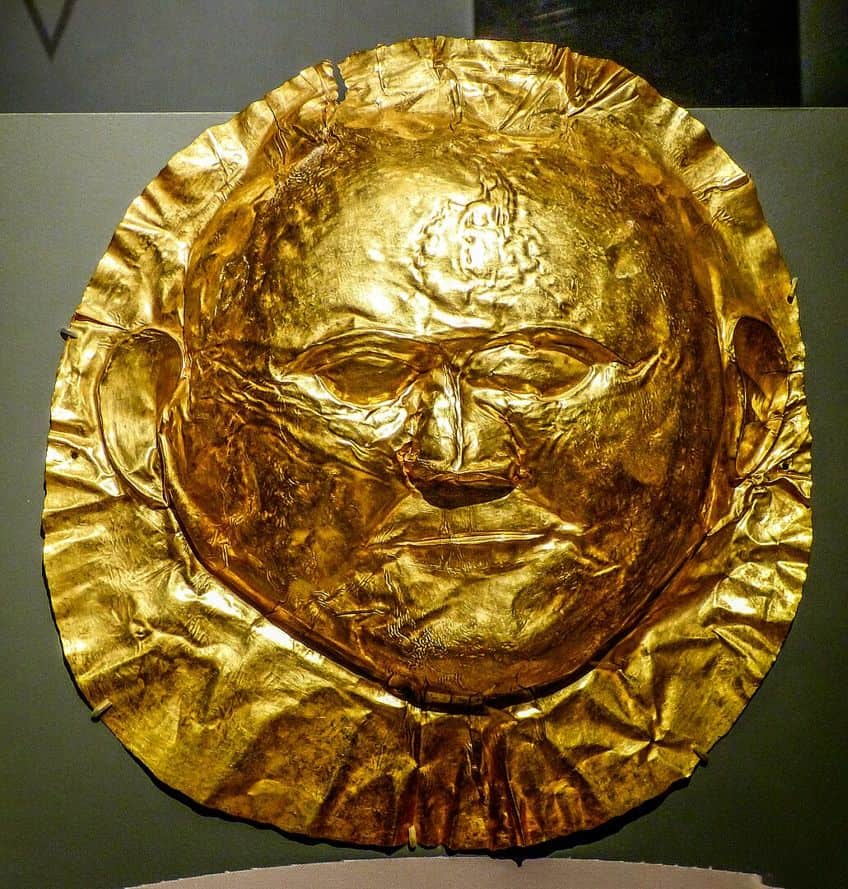
The masks recovered in Grave Circle A depict both young and old faces. Additional Mycenaean artifacts discovered in these shaft tombs include finely decorated metal and golden cups, weaponry, and jewelry, all of which demonstrate the Mycenaeans’ metallurgical skills. Mastery of repoussé, the hammering of shapes from the back of a metal sheet to produce a sculpted relief, with details afterward added from the front using various techniques, was required. According to scholars, the complex Mycenaean political and economic structure led to increased luxury among the society’s aristocratic members, and affluence that these burial artifacts testified to.
Mycenaean Sculptures
While the Mycenaeans’ rising power and wealth enabled them to create greater sculptures than prior Aegean nations, the most common pieces of Mycenaean art unearthed in their tombs and graves were modest figurative sculptures. The majority of Mycenaean sculptures depicted female figures with round or expanded midsections and varying arm poses. Although resembling the simple carved Cycladic figurines of the beginning of the Bronze Age, Mycenaean tomb sculptures are often terracotta, clay baked in kilns, and less geometrical in form. Also, they typically have painted features that are well-preserved. Many of these Mycenaean sculptures have the same upraised arm gesture first observed in Minoan “goddess” monuments.
There is such a variety of these Mycenaean figures that they are divided into three primary categories based on the motions of their arms and were titled after the Greek letters phi, tau, and psi.
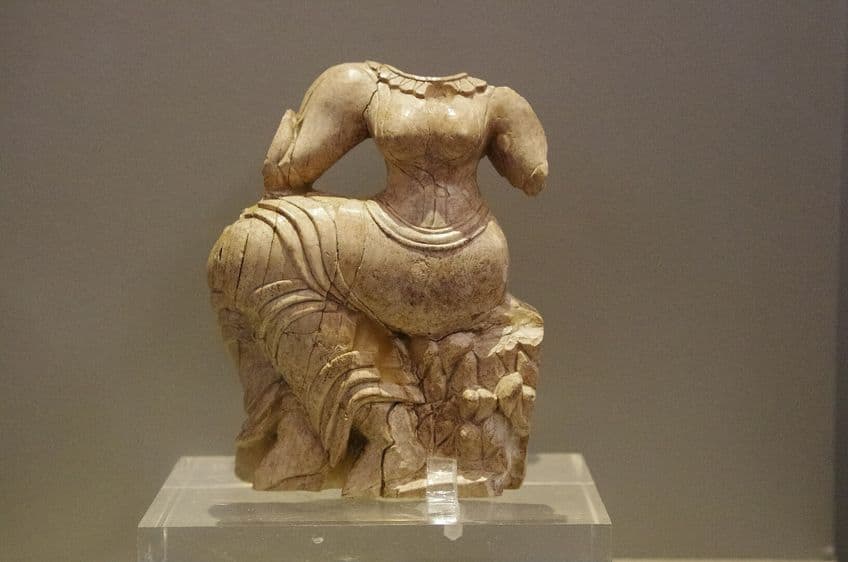
The tau figures tuck their arms into their breast, the phi figures clutch their hands over their stomach, and the psi figures lift their hands. Like with other Aegean artworks, the function of these Mycenaean sculptures can only be speculated. Experts believe these are deity representations for votive purposes or toys for children, as several have been discovered in children’s tombs. Given the variety of discovery locations and indications that some were intentionally damaged and abandoned, they could have served particular functions both during and after life. The existence of many of these statues on sites of worship in the Archaic and Classical periods suggests that many of them were religious in nature, possibly as votives, but also that future places of worship may have first been used in the Mycenaean period.
Mycenaean Vessels
Mycenaean vessels had parallels covering a wide region of the Eastern Mediterranean during the Late Mycenaean era, probably representing a type of political and economic unity centered at Mycenae. Nonetheless, Crete’s Minoan pottery stayed unique during this period, demonstrating a level of independence on the island. Stirrup jars, big bowls, krater, alabastron, and stemmed cups resembling champagne glasses were all created in vast quantities by the Mycenaean Greeks.
Stirrup jars, in particular, were created in the 16th century BCE on the island of Crete and were extensively used by the Mycenaean people from 1400 BCE onward for carrying and preserving oil and wine; the jars were generally globular or pear-shaped.
Stemmed cups developed from Ephyraean goblets, and a huge amount was uncovered in Zygouries at a location known as the “Potter’s Shop”. Mycenaean drinking containers, including stemmed cups, have single ornamental motifs painted on the exterior facing away from the drinker, which may include an octopus, shell, or a flower. The Mycenaeans also painted full scenes on their vessels, representing soldiers, horses, chariots, and deities from Homer’s Iliad. Additional Mycenaean creations include clay lamps and metallic objects such as bronze tripod cauldrons. There are also a few instances of faience and ivory vessels.
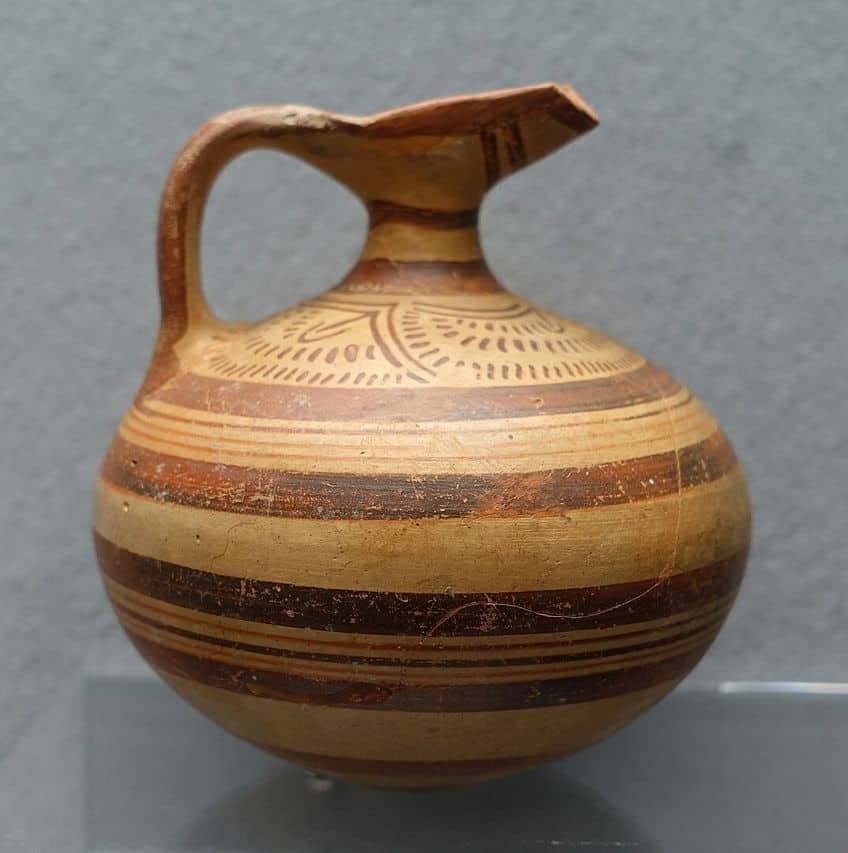
One of the most well-known vessels known as the Warrior Vase was produced sometime around 1200 BCE. It’s a bell krater vessel with a woman waving farewell to a band of warriors. The image is plain, with no backdrop. The warriors all wear helmets and wield round shields and spears. Knapsacks are tied to their spears, implying that they have to travel considerable distances to fight. On one side, the troops wear helmets decorated with horns. The warriors on the opposing side are outfitted in hedgehog-style helmets. A solitary lady stands to the side with her arm up while a group of identically clothed, highly armed males stands to the left with their arms raised.
There is no way to know which person the woman is waving farewell to because all of the characters are generic and none of them interact with her or with one other.
The figurines are stocky, with no sinuous lines like the painted Minoan characters. Additionally, while the men all have wider stances and seem to walk in that direction, their flat feet and twisted viewpoint bodies hinder any sense of movement. The figurines, rather, stay immobile and erect. The artwork represents a simple tale that must have been reenacted frequently in the Mycenaean warrior culture.
Myceneaen Bronze Daggers
Artistic bronze daggers discovered in burial shafts indicate that Mycenaean craftsmen were influenced by a diverse range of cultures. These ceremonial daggers were crafted of bronze and inlaid with motifs obviously inspired by foreign civilizations in gold, silver, and niello. Two unearthed daggers represent hunting scenes, indicating an Ancient Near East influence.
The first scene portrays lions hunting prey, while the second portrays a lion hunt.

The depiction of the characters in the lion chase scene is strongly inspired by Minoan art figures. These women have slim waists, wide shoulders, and powerful thighs. Another Minoan influence is the scene between the humans and the lions, which is dynamic and full of vitality. Another dagger demonstrates the impact of Minoan painting and iconography in the representation of sea life, while Egyptian themes can be observed on a dagger laden with papyrus reeds and lotuses, as well as birds.
Mycenaean Frescoes
The Mycenaean Frescoes originated in Minoan Crete, where they first emerged about 1700 BCE in chambers of palaces and other opulent buildings. The first Mycenaean paintings were created in the 15th century, roughly during the second building period of the Minoan palaces. While the most severe Minoan influence happened during the initial stages of the Mycenaean era, it is highly possible that this art had entered mainland Greece sooner. Some archaeological evidence, such as colored plasters of structures from the Middle Helladic era and fresco pieces from the citadel of Mycenae discovered with pottery from the Late Helladic I and II eras, support this theory.
The majority of Mycenaean paintings are from the 14th and 13th century BCE and are associated with the palace apartments of Tiryns, Mycenae, and Pylos, or with local leaders’ seats such as Argos, Gla, and the Menelaion.
The fresco decoration was an undeniable sign of distinction, but its presence in private buildings demonstrates that it was not an exclusive luxury of the leaders. Apart from their presence in official architecture, Mycenaean frescoes have been uncovered at prominent people’s tombs and religious places. The Mycenaean paintings, like the Minoan frescoes, were drawn compositions on plaster using the fresco method. The design needed to be finished before the plaster dried. That is why the drawing of enormous iconographic compositions requires considerable skill and a vast team of artisans working at the same time.
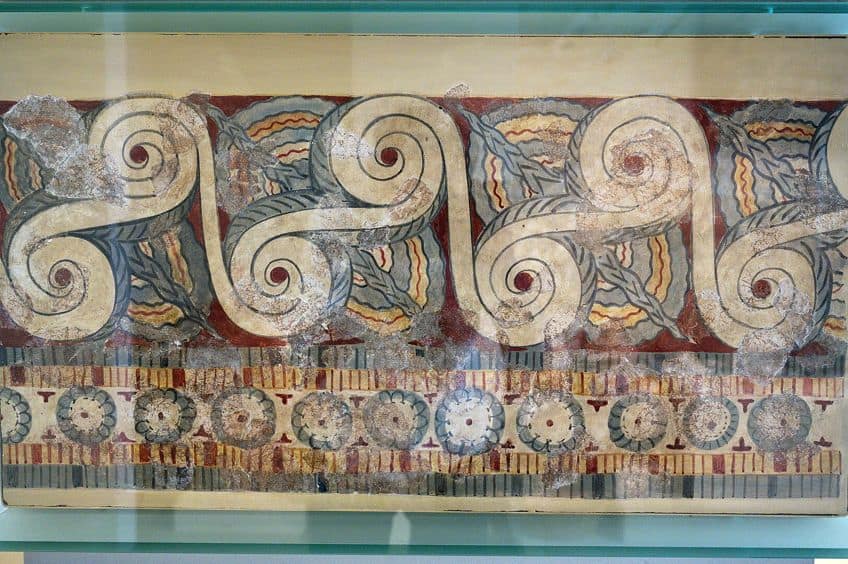
The paints used had an earthly feel and were red, blue, yellow, and black in color. The same method was used on portable Mycenaean artifacts, as seen by the painted tombstones, clay larnakes, and numerous limestone-plastered tiles. The subjects of the Mycenaean paintings may be divided into three categories: iconographic depictions of the population’s religious life, portrayals of the ruling class’s favorite activities, and abstract ornamental themes. The latter is used as a frame for the images as well as ornamental coverings on floors, ceilings, and other surfaces. The fresco decorating process was divided into three stages. The primary painting was put in the center of an outlined jamb that was painted to look like veined marble and placed in a decorative band.
The portrayal of architectural materials, particularly wooden beams, was also popular.
The so-called miniature style, which is represented on long friezes depicting depictions with small-scale characters, has a distinct Mycenaean character. In terms of iconographic depictions, the Cretan influence in the design and selection of subjects is apparent. The Mycenaean paintings, like the Minoan frescoes, feature bull-leaping, malevolent monsters, and architectural aspects. The hunting and war scenes, as well as processions of ladies in costume bringing offerings, were uniquely Mycenaean subjects. These fresco themes depict the Mycenaean aristocracy’s religious and heroic spirit.

The war scenes have a narrative quality and most likely portray specific times or historical occurrences. The subjects and fresco techniques seem to have inspired later Mycenaean iconographic arts. Ivory carving, ceramics, and seal carving all have comparable classifications of iconographic subjects. The paintings of the 13th century BCE, which were no longer based on Minoan models, developed a distinct Mycenaean character, characterized by intense schematization, stiffness, and inartistic composition. The collapse of the palaces about 1200 BCE signaled the end of mural painting associated with governmental buildings. The sole remnants of the ancient art are a few makeshift paintings at the shrine of Tiryns’ Lower Citadel.
The Influence of Mycenaean Art
Mycenaean art had a profound effect on future cultures, notably the ancient Greeks. Mycenaean pottery was distinguished by its elaborate patterns and designs, which were sometimes painted in dark colors on a light backdrop. This ceramic type had an impact on subsequent Greek pottery, notably the red-figure and black-figure styles.
Mycenaean art featured events from mythology, such as Hercules’ Labors and the Trojan War. These legends were later recounted in Greek literary and artistic works.
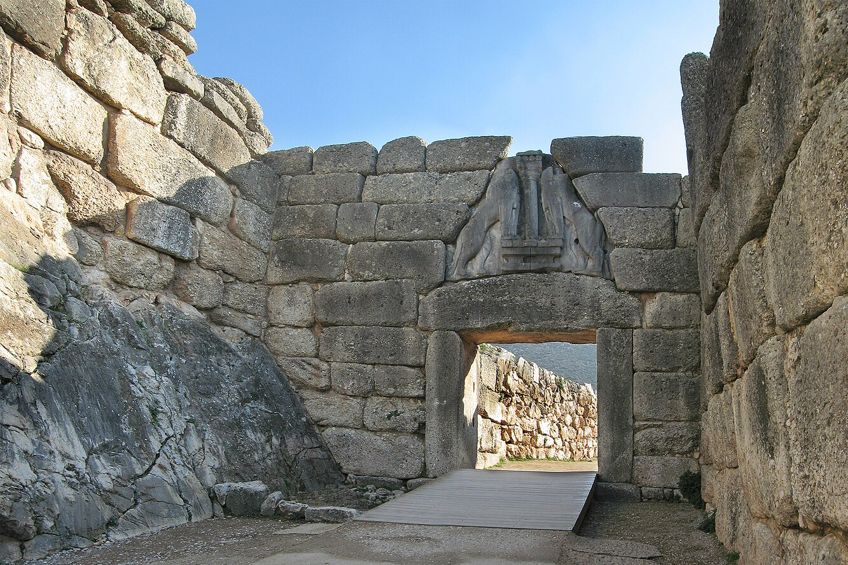
Mycenaean craftsmen were proficient in gold and jewelry fabrication, which inspired subsequent Greek jewelry-making. Later Greek jewelry continued the elaborate motifs and patterns employed in Mycenaean jewelry. Mycenaean monumental architecture, such as the Lion Gate at Mycenae inspired subsequent Greek architecture. Several aspects of Mycenaean architecture, such as the use of massive stone blocks and columns, were adopted by later Greek structures.
That concludes our article about Mycenaean art. Although thousands of years old, the art of the Mycenaean civilization has been extraordinarily well preserved. The Mycenaean civilization was one of the most significant in ancient Greece, and its art gives unique insights into the people’s culture, ideas, and lifestyle of that period. The Mycenaean civilization’s art had a great impact on the following cultures, notably the ancient Greeks. Several aspects of Mycenaean art were carried over into later Greek art and culture, such as the use of massive stone blocks in construction and complex motifs in pottery and jewelry.
Frequently Asked Questions
Who Were the Mycenaeans?
During its peak, the Mycenaean civilization was a prominent power in the eastern Mediterranean. The Mycenaeans were excellent warriors and traders who created a sophisticated government and social order. The Mycenaeans produced works of art and literature that are still studied and revered today, as well as stunning palaces, fortresses, and tombs. The Mycenaeans were most likely a combination of indigenous Greeks and eastern Mediterranean migrants. They spoke a dialect of Greek known as Mycenaean Greek, which is one of the oldest varieties of the Greek language to be documented.
What Characterized Mycenaean Art?
A focus on colossal structures, exquisite frescoes, intricately decorated ceramics, and opulent gold jewelry are characteristics of Mycenaean art. The art usually illustrates themes from mythology, military equipment, and everyday life. The methods employed by Mycenaean painters varied and included relief carving, goldsmithing, and fresco painting. Animals like lions and bulls are often depicted in artwork, along with geometric designs and floral elements.
Isabella studied at the University of Cape Town in South Africa and graduated with a Bachelor of Arts majoring in English Literature & Language and Psychology. Throughout her undergraduate years, she took Art History as an additional subject and absolutely loved it. Building on from her art history knowledge that began in high school, art has always been a particular area of fascination for her. From learning about artworks previously unknown to her, or sharpening her existing understanding of specific works, the ability to continue learning within this interesting sphere excites her greatly.
Her focal points of interest in art history encompass profiling specific artists and art movements, as it is these areas where she is able to really dig deep into the rich narrative of the art world. Additionally, she particularly enjoys exploring the different artistic styles of the 20th century, as well as the important impact that female artists have had on the development of art history.
Learn more about Isabella Meyer and the Art in Context Team.
Cite this Article
Isabella, Meyer, “Mycenaean Art – A Deep Dive into Mycenaean Artifacts.” Art in Context. June 1, 2023. URL: https://artincontext.org/mycenaean-art/
Meyer, I. (2023, 1 June). Mycenaean Art – A Deep Dive into Mycenaean Artifacts. Art in Context. https://artincontext.org/mycenaean-art/
Meyer, Isabella. “Mycenaean Art – A Deep Dive into Mycenaean Artifacts.” Art in Context, June 1, 2023. https://artincontext.org/mycenaean-art/.





